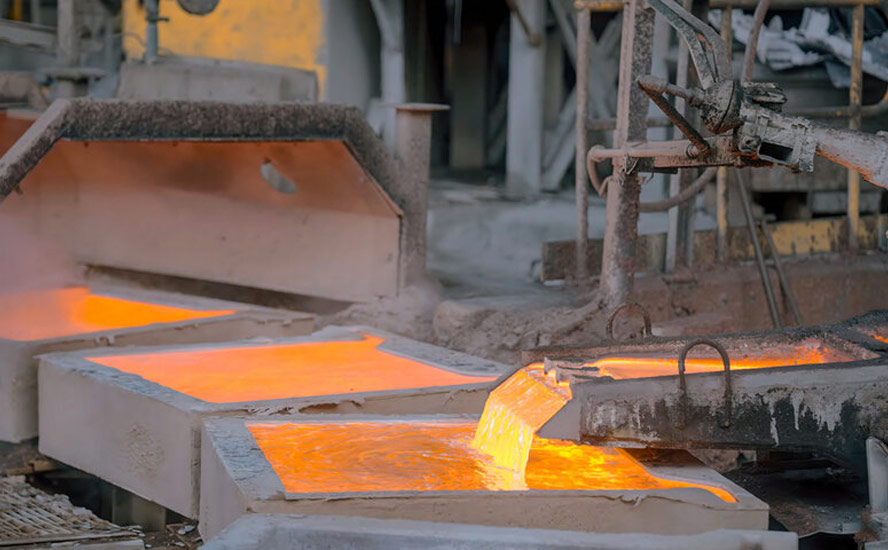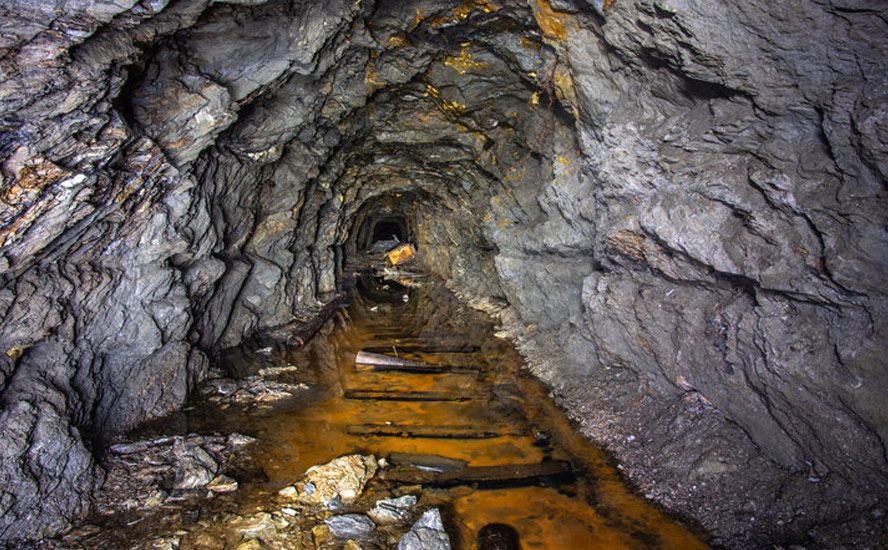Mountain Boy drilling for Premier look-alike at American Creek
2020.10.17
British Columbia’s Premier Mine opened in 1918 and was the largest gold mine in North America until it closed in 1953, producing 2 million ounces of gold and 45 million ounces of silver.
Located in a prolific mining area that would later become known as the “Golden Triangle,” Premier was the first gold mine among several to open in this richly mineralized corner of northwestern BC. It was a large employer, with bunkhouses, generators, concentrators and cook houses dotted along the steep hillsides. Horses and cat tractors were used to transport the ore and waste rock.
In 1989 Westmin Resources re-opened Premier as a combination open-pit/ underground operation. A mill was built and the mine continued until 1996, processing up to 2,850 tons per day. The open-pit portion produced around 260,000 ounces of gold and 5.1Moz of silver, until Boliden purchased it from Westmin and the mine was shut down in 2001. Two decades later, exploration companies operating in the Golden Triangle are aiming to breathe new life into Premier and other high-grade gold deposits that surround it.
Ascot Resources (TSX:AOT) has just released robust results on a feasibility study that would involve developing four underground mining operations at the past-producing Silver Coin, Big Missouri, Premier and the new Red Mountain deposit. The four mines would feed a refurbished 2,500-tpd mill at Premier.
And over 100 years after Premier poured its first gold bar, junior gold company Mountain Boy Minerals (TSX-V:MTB) believes it has found similar mineralization at its American Creek project, located 22 kilometers north of Stewart, a deep-water ocean port, and Hyder, Alaska.
A 4,000m drill program is underway, with a second drill rig recently added. The Vancouver-based company has crews in the field as it aims to complete 20-30 holes in three target areas before the first snow fall of the season.
The Golden Triangle
About 150 million years ago during the Jurassic geological period, an uplift of Jurassic and older rocks cut across central British Columbia and resulted in the separation of the Bowser and Nechako basins. Rocks exposed along the “Skeena Arch” represent a magmatic arc, where over a long period of time, magma rose up from deep in the earth to produce a wide range of mineral deposits including porphyries, precious metal veins, and coal.
The Skeena Arch has some of the mostly richly endowed mineral terrain in BC and has been a destination for prospectors and mining companies for the past 125 years. The map below shows the Golden Triangle where a lot of historical exploration and mining has taken place in the last century and a quarter, and where over the past few years juniors have rushed in to stake claims, as mineral exploration conditions and the gold market have improved.
The Stikine Arch is one of four terranes – distinct geological structures with different histories – along with Cache Creek, Yukon-Tanana and Cassiar, which form the bedrock of the Northern Cordilleran Volcanic Province, a wide belt of volcanoes that extends all the way from Stewart, BC in the south, through the Alaska Panhandle north to eastern Alaska. According to a presentation by Geoscience BC, “World class gold-rich deposits are associated with the Late Triassic, and Early Jurassic intrusive suites in NW Stikinia.” The non-profit research group also states that bulk-tonnage copper/ gold/ silver porphyries in the Stikinia, and bonanza-grade gold and silver epithermal veins, are associated with the Early Jurassic period, such as the KSM (Seabridge), Snowfield and Brucejack (Pretium) deposits.
Just inland from the Alaska Panhandle, the Golden Triangle has been the site of three gold rushes and some of Canada’s greatest mines, including Premier, Snip and Eskay Creek. Other significant and well-known deposits in the Triangle include Brucejack, Galore Creek, Copper Canyon, Schaft Creek, KSM, Granduc, and Red Chris.
Alexander Choquette kicked off the Stikine Gold Rush in 1861 after finding gold at the confluence of the Stikine and Anuk Rivers.
The first producing gold mine was Premier and in 1938, Cominco opened the Big Missouri Mine, located just 6 km north of Premier. The mine operated until 1941, when World War II forced its closure.
The Snip Gold Mine produced a million ounces in the 1990s at an eye-popping average grade of 27.5 grams per tonne (g/t). The mine, discovered by Cominco, stayed dormant until 1986, and was drilled in a JV by Delaware Resources.
In 1988 after 109 drill holes, tiny exploration company Stikine, and Calpine Resources finally hit the hole they needed at Eskay Creek.The Eskay Creek Mine would go on to become Canada’s highest-grade gold mine and the world’s fifth largest silver producer, with production well over 3 million ounces Au and 160 million ounces Ag, before it closed in 2008.
Porphyry copper-gold deposit Galore Creek, now owned jointly by Newmont (TSX:NGT) and Teck Resources (TSX-B:TECK), has 9 billion pounds of copper, 8 million gold ounces and 136 million ounces of silver. Another porphyry, Shaft Creek, a JV between Copper Fox Metals (TSX-V:CUU) and Teck, contains 5 billion pounds of copper, 5.8 million ounces of gold, 363.5 million pounds of molybdenum and 51.7 million ounces of silver.
Dormancy and revival
But after decades of productive mining and some big discoveries, the Golden Triangle went dormant. Isolated from major infrastructure, the area was expensive to conduct exploration, and due to its harsh winter climate, was only accessible for half a year. Not much news came out of the Golden Triangle during the 1990s and 2000s. When gold prices weakened, to about $400 an ounce, several mines shut down, unable to make a decent margin against fixed costs.
Despite over 130 million ounces of gold, 800Moz of silver and 40 billion pounds of copper found in the area, the tip of the surface has only been scratched. The BC Geological Survey database has identified over 900 mineral occurrences, 67 of which have documented mineral resources. Lately there has been a resurgence of interest in the Golden Triangle, as juniors position themselves for the next discovery hole. So what changed? The excitement is driven mainly by three factors: higher gold prices, new infrastructure, and modern discoveries.
Today, road access is easy and a new transmission line, courtesy of the BC government, has dramatically reduced the cost of power for companies operating in the Triangle. With the opening of ocean port facilities for export of concentrate at Stewart, the infrastructure is primed and ready.
In 2009 exploration drilling at the Valley of the Kings deposit – the site of a former gold mine – hit a bonanza hole of four mineralized gold bands, with the highest grading 16,949 g/t, leading to a 33,000-meter drill program in 2010. New company Pretium had some of the richest ore in the world. After a feasibility study in 2013 and permits and financing in 2015, mine construction started in 2016, with the first gold pour in the summer of 2017.
Also critical to the revival of the Triangle was Seabridge’s KSM project. Considered the largest gold project in the world, with reserves of 38.8 million ounces of gold, 10.2 billion pounds of copper and 183 million ounces of silver, KSM was greenlighted by the Canadian federal government in 2014. Earlier this year, Seabridge released a technical report outlining a 44-year mine production plan, aiming to recover 19.6Moz of gold and 5.5 billion pounds of copper from its measured and indicated resources, plus 20.8Moz Au and 13.8 billion pounds Cu from the inferred category.
Then there’s Red Chris. At first run by Imperial Metals, then 70%-purchased by Australia’s Newcrest in 2019, this $700 million gold and copper mine entered production in 2015 and is expected to go until 2043.
As mentioned low gold prices shut down several operating mines in the Golden Triangle during the 1990s and early 2000s, and also squelched exploration. Since then, much better economics due to significantly higher gold and silver prices, has injected gold fever back into the area, and combined with new geological theories and techniques, breathed new life into the possibility of discoverers hitting the next Valley of the Kings or KSM.
American Creek
The story of Mountain Boy Minerals’ involvement in the Golden Triangle, particularly the area east of the old Premier Mine, about 20 km from Stewart, begins in the early 2000s when the company and predecessors began picking up claims around the historic Mountain Boy Mine.
In 2006, Mountain Boy conducted a 19-hole drill campaign around the old Mountain Boy silver mine that lies at the center of American Creek. A small underground drill was used. The average hole length was 47 meters – barely scratching the surface. The focal point was the aptly named High Grade Vein, which was the heart of the historic mining. Six holes in that vein intercepted more than a kilogram of silver over at least a meter, with the highlight being hole 2006-10 which hit 5,258 g/t over 5.18 meters. (5 kg is 160 troy ounces)

Having consolidated a 26 square km land position, Mountain Boy now holds a significant land package that is host to a variety of targets, with several known mineral occurences, all of which are underexplored.
MTB considers the area to have real potential to host more than one deposit. The presence of numerous nearby past producers, an evolving understanding of the geology, and encouraging results in the region, all support the highly prospective nature of the area.
“The Golden Triangle is so exciting because it has yielded several world-class deposits,” says Lucia Theny, Mountain Boy’s VP Exploration/ head geologist. “It’s in an area that is extremely well endowed with silver, gold, base metals, the works, and people continue to have success exploring it now.”
CEO Lawrence Roulston is a 40-year mining industry veteran, with stints at both junior and major mining companies. For several years Roulston was Editor of the well-respected Resource Opportunities newsletter.
“In Mountain Boy I saw the enormous potential in these properties [along with American Creek, Mountain Boy’s Golden Triangle portfolio comprises the Red Creek, BA, Surprise Creek and Southmore projects] and I was really keen to get involved,” Roulston relates, in a documentary-style, on-site video of the American Creek project, recently produced by Ahead of the Herd.
“I took control of the company, brought together a really exceptional geological team, we expanded the property position, compiled a mountain of information on these properties going back decades. Putting it all together, we were more convinced than ever these properties have something of substance. Now we’re demonstrating the potential of what we’ve got with the drill bit.”
The big game-changer came in the summer of 2018, when Theny and her team carried out the first systematic exploration along the American Creek valley. A soil grid was put in to follow up on some intrusive dykes that the team had mapped. Closer examination of some gossanous rocks found in the course of the soil grid resulted in finding an intrusion that had never previously been mentioned. Theny noted the similarity to the Premier porphyry, the driving force for mineralization in the Premier district. Geochron analysis (dating) confirmed Early Jurassic – the same age as the Early Jurassic intrusion at the heart of the Premier District, the same minerology, similar alteration and a similar scale.
‘The beauty of that soil grid was it led us to what we now call the American Creek intrusion,” says Theny. “You’d hold it up and you’d say wow, that could have come straight out of the Premier porphyry.”
Further prospecting and mapping demonstrated that the intrusion runs along American Creek for several kilometers. Exactly how far remains to be seen.
Mineralization
According to MTB, the American Creek project has multiple styles of mineralization, which closely parallels the situation at Premier. The predominant style consists of epithermal silver-dominant polymetallic veins associated with a medium sulfidation hydrothermal system. That system appears to be directly related to the recently outlined Early Jurassic intrusion. This is the dominant style around the Mountain Boy Mine. The high grades of silver, and the minerology and rock textures point to that area being high in a hydrothermal system. Such systems sometimes transition to more gold-dominant at depth.

According to Theny, the different types of mineralization at American Creek may indicate the potential for multiple deposits, as was the case with historical Golden Triangle mines, like Premier and Big Missouri.
“We have this known occurrence of mineralization, at the Mountain Boy Mine, and then some distance away, another less explored mineralization,” she said. “The Premier had several different deposits over an area, so that’s what we think we’re seeing too.”
3 targets
Diamond drills are currently spinning on a 4,000-meter campaign aimed at finding high-grade silver and gold mineralization in three target areas.
This year’s fully funded exploration program includes:
- Property-wide LiDar survey, now complete.
- Induced Polarization (IP) geophysical survey, also complete.
- 4,000-meter drill program targeting three mineralized zones. Drilling began as scheduled, on Sept. 16 on the Wolfmoon target. The third hole is being completed. The second drill is targeting the High-Grade vein on the MB Silver target, where at least three drill holes are planned. Six of the seven planned drill pads have been built and a fourth is being constructed. Four of these pads are testing areas that have never been drilled before.
Designed to confirm the geological model, ie., that the various mineralized occurrences are surface expressions of a large geological system, analogous to the nearby Premier District, the three targets are:
Wolfmoon
The IP survey focused on the recently discovered Wolfmoon zone; it was the first target to be drilled, and the crew is now finished there. Interestingly, Wolfmoon is believed to be at a higher stratigraphic level than the veins around the old mine. Notably, the Wolfmoon mineralization is found at the transition between volcanic and sedimentary rocks. This stratigraphic position hosts volcanogenic massive sulfide deposits such as Eskay Creek and elsewhere in the Golden Triangle.
Surface samples with high gold and silver grades were identified within an extensive alteration zone, which has recently emerged from ice cover. The best grab samples were 28.5 g/t gold and 1,200 g/t silver.

MB Silver
Drilling around the historic Mountain Boy Mine follows up the 2006 drill program, the intention being to test the high-grade zone for continuity, along strike and at depth.
The aptly named High Grade Vein was the heart of the historic mining. Six holes in that vein intercepted more than a kilogram of silver over at least a meter, with the highlight being hole 2006-10 which hit 5,258 g/t over 5.18 meters. These results have never been followed up. Until now. The untested Franmar vein will also be drilled.
The way the drill pads were set up at this target is unique, and to the casual observer, palm sweating – they are literally perched on the side of the mountain.
The east side of Bear River ridge, where Mountain Boy’s claims at MB Silver straddle, is steep. A drill pad and a heli-pad are situated higher up the mountain from an existing adit, with the drill pointing down towards the old workings.
According to Theny, “One of the ways we thought we could add value was to potentially use [the heli-pad] as a drill site. These drill pads are amazing and robust – a helicopter can shut down on them – but they’re also thousands and thousands of dollars, so we’re going to basically flip the two, so our drill pad we’re using right now will turn into our heli-pad. And that’s how we save money.”
Mountain Boy is being helped in this kind of difficult terrain by Andrew Wilkinson. A veteran geo who has been working in the Golden Triangle since the mid-1980s, Wilkinson is also an expert rock climber. According to CEO Roulston, Wilkinson has been able to get to areas to collect samples, that no other geologist would be able to.
“You have to ask yourself, are you gonna be able to develop a mine in these really rugged mountains?” Wilkinson asks rhetorically. “The reality is in today’s world we have helicopters, we have incredible technology, you look in the area there’s some really good prospects that’ve been developed here. They’ve had major hurdles and they’re making money. That’s what it’s all about.”
What does MTB expect to find at the MB Silver target? Obviously another 5,000 g/t Ag hit would be ideal. It’s been drilled in the past and Mountain Boy is really looking to intercept that high-grade mineralization again.

Dorothy
The third target is the northern extension of the Mountain Boy Mine’s silver-bearing veins, onto the recently optioned Dorothy property.
Ongoing geological work, including mapping and structural interpretation, is enhancing the understanding of the mineralization and the orientations of these multiple silver veins.
There are 15 discovered vein occurrences within the Dorothy property and Mountain Boy has interpreted them to be part of the same hydrothermal system that deposited high-grade silver at the Mountain Boy Mine. Could the High-Grade Vein, and others in the system at the mine, extend north 2 km onto Dorothy? We don’t know, but the possibility is intriguing.
Drilling is also planned for the Maybee zone and the untested Upper Ruby zone.
LiDar survey
To support the drill targeting, an airborne LiDar survey (“laser imaging, detection, and ranging”) has been flown over the entire property. LiDar provides accurate topographic information, useful for structural mapping and interpretation, topographic control for drill targets, and tying together the results from earlier work that has been conducted by multiple operators working independently on small portions of the current property. Given the steep nature of the eastern portion of the property, the LiDar survey is invaluable for providing ground control for drilling the epithermal veins, which have yielded high-grade silver in the past.
“In addition,” says Theny, “Lidar has this amazing feature where they can strip off the vegetation, and give you a bare earth image. What this bare earth image provides is an amazing opportunity for a structural interpretation. You can see all the lineaments and cracks, we’re talking like 15 cm resolution vertically and 10 cm horizontally. You could almost map out boulders with the LiDar and we think it’s gonna be a fabulous tool for us.”
District-scale is the goal
All well and good, but what is the CEO expecting from this year’s exploration program? And what kind of signal is he hoping to send to the market? A little surprisingly, Roulston says the best result isn’t necessarily high-grade Au/ Ag. Like all vein systems, the intensity of the mineralization varies along the vein. Instead, his main objective is to prove the extent of the mineralization.
“We’re drilling three distinct target areas, any one of these could be a company maker,” Roulston says with confidence.
“We’re counting on some big hits on the grade on these initial drill holes, but whether or not we get the grade the real objective of the current drilling program is to demonstrate the extent of the veins. We know it’s a really extensive geological system that spans several kilometers. We see individual veins that we know go for hundreds of meters, and if we can drill into these veins in different places and demonstrate we’ve got the potential for size, then that will really advance the project enormously. If we get grade as well as size, then that’s a bonus.”
“We are intent on demonstrating that this is a district-scale project exactly like the Premier District west of us, where there are multiple high-grade deposits over an extensive area. We believe we’ve got exactly the same as on the Premier camp and this drilling will be the first indication leading us in that direction.”
Conclusion
Mountain Boy Minerals is active in one of the best jurisdictions for base and precious metals exploration.
The Triangle is also one of only a few billion-ounce silver districts in the world.
Mountain Boy’s theory of multiple mineralizing events at American Creek is being tested. Shortly, evidence might be forthcoming of a district-scale opportunity that will create an enormous amount of interest, from the market and larger mining companies.
Mountain Boy Minerals
TSX.V:MTB, Frankfurt:M9UA
Cdn$0.425, 2020.10.16
Shares Outstanding 49,078,051m
Market cap Cdn$20.85m
MTB website
Richard (Rick) Mills
aheadoftheherd.com
subscribe to my free newsletter
Ahead of the Herd Facebook
Legal Notice / Disclaimer
Ahead of the Herd newsletter, aheadoftheherd.com, hereafter known as AOTH.
Please read the entire Disclaimer carefully before you use this website or read the newsletter. If you do not agree to all the AOTH/Richard Mills Disclaimer, do not access/read this website/newsletter/article, or any of its pages. By reading/using this AOTH/Richard Mills website/newsletter/article, and whether or not you actually read this Disclaimer, you are deemed to have accepted it.
Any AOTH/Richard Mills document is not, and should not be, construed as an offer to sell or the solicitation of an offer to purchase or subscribe for any investment.
AOTH/Richard Mills has based this document on information obtained from sources he believes to be reliable but which has not been independently verified. AOTH/Richard Mills makes no guarantee, representation or warranty and accepts no responsibility or liability as to its accuracy or completeness. Expressions of opinion are those of AOTH/Richard Mills only and are subject to change without notice. AOTH/Richard Mills assumes no warranty, liability or guarantee for the current relevance, correctness or completeness of any information provided within this Report and will not be held liable for the consequence of reliance upon any opinion or statement contained herein or any omission. Furthermore, AOTH/Richard Mills assumes no liability for any direct or indirect loss or damage or, in particular, for lost profit, which you may incur as a result of the use and existence of the information provided within this AOTH/Richard Mills Report.
AOTH/Richard Mills is not a registered broker/financial advisor and does not hold any licenses. These are solely personal thoughts and opinions about finance and/or investments – no information posted on this site is to be considered investment advice or a recommendation to do anything involving finance or money aside from performing your own due diligence and consulting with your personal registered broker/financial advisor. You agree that by reading AOTH/Richard Mills articles, you are acting at your OWN RISK. In no event should AOTH/Richard Mills liable for any direct or indirect trading losses caused by any information contained in AOTH/Richard Mills articles. Information in AOTH/Richard Mills articles is not an offer to sell or a solicitation of an offer to buy any security.
AOTH/Richard Mills is not suggesting the transacting of any financial instruments but does suggest consulting your own registered broker/financial advisor with regards to any such transactions
Richard owns shares of Mountain Boy Minerals (TSX.V:MTB, Frankfurt:M9UA). MTB is a paid advertiser on Richard’s site aheadoftheherd.com
Legal Notice / Disclaimer
Ahead of the Herd newsletter, aheadoftheherd.com, hereafter known as AOTH.Please read the entire Disclaimer carefully before you use this website or read the newsletter. If you do not agree to all the AOTH/Richard Mills Disclaimer, do not access/read this website/newsletter/article, or any of its pages. By reading/using this AOTH/Richard Mills website/newsletter/article, and whether you actually read this Disclaimer, you are deemed to have accepted it.




























